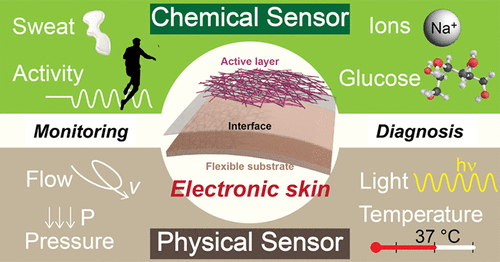当前位置:
X-MOL 学术
›
Acc. Chem. Res.
›
论文详情
Our official English website, www.x-mol.net, welcomes your
feedback! (Note: you will need to create a separate account there.)
Flexible Electronics toward Wearable Sensing.
Accounts of Chemical Research ( IF 16.4 ) Pub Date : 2019-02-15 , DOI: 10.1021/acs.accounts.8b00500 Wei Gao 1 , Hiroki Ota 2 , Daisuke Kiriya 3 , Kuniharu Takei 3 , Ali Javey 4, 5, 6
Accounts of Chemical Research ( IF 16.4 ) Pub Date : 2019-02-15 , DOI: 10.1021/acs.accounts.8b00500 Wei Gao 1 , Hiroki Ota 2 , Daisuke Kiriya 3 , Kuniharu Takei 3 , Ali Javey 4, 5, 6
Affiliation

|
Wearable sensors play a crucial role in realizing personalized medicine, as they can continuously collect data from the human body to capture meaningful health status changes in time for preventive intervention. However, motion artifacts and mechanical mismatches between conventional rigid electronic materials and soft skin often lead to substantial sensor errors during epidermal measurement. Because of its unique properties such as high flexibility and conformability, flexible electronics enables a natural interaction between electronics and the human body. In this Account, we summarize our recent studies on the design of flexible electronic devices and systems for physical and chemical monitoring. Material innovation, sensor design, device fabrication, system integration, and human studies employed toward continuous and noninvasive wearable sensing are discussed. A flexible electronic device typically contains several key components, including the substrate, the active layer, and the interface layer. The inorganic-nanomaterials-based active layer (prepared by a physical transfer or solution process) is shown to have good physicochemical properties, electron/hole mobility, and mechanical strength. Flexible electronics based on the printed and transferred active materials has shown great promise for physical sensing. For example, integrating a nanowire transistor array for the active matrix and a conductive pressure-sensitive rubber enables tactile pressure mapping; tactile-pressure-sensitive e-skin and organic light-emitting diodes can be integrated for instantaneous pressure visualization. Such printed sensors have been applied as wearable patches to monitor skin temperature, electrocardiograms, and human activities. In addition, liquid metals could serve as an attractive candidate for flexible electronics because of their excellent conductivity, flexibility, and stretchability. Liquid-metal-enabled electronics (based on liquid-liquid heterojunctions and embedded microchannels) have been utilized to monitor a wide range of physiological parameters (e.g., pulse and temperature). Despite the rapid growth in wearable sensing technologies, there is an urgent need for the development of flexible devices that can capture molecular data from the human body to retrieve more insightful health information. We have developed a wearable and flexible sweat-sensing platform toward real-time multiplexed perspiration analysis. An integrated iontophoresis module on a wearable sweat sensor could enable autonomous and programmed sweat extraction. A microfluidics-based sensing system was demonstrated for sweat sampling, sensing, and sweat rate analysis. Roll-to-roll gravure printing allows for mass production of high-performance flexible chemical sensors at low cost. These wearable and flexible sweat sensors have shown great promise in dehydration monitoring, cystic fibrosis diagnosis, drug monitoring, and noninvasive glucose monitoring. Future work in this field should focus on designing robust wearable sensing systems to accurately collect data from the human body and on large-scale human studies to determine how the measured physical and chemical information relates to the individual's specific health conditions. Further research in these directions, along with the large sets of data collected via these wearable and flexible sensing technologies, will have a significant impact on future personalized healthcare.
中文翻译:

面向可穿戴传感的柔性电子。
可穿戴式传感器在实现个性化药物方面起着至关重要的作用,因为它们可以不断地从人体收集数据以及时捕获有意义的健康状况变化,以进行预防性干预。但是,传统的刚性电子材料和柔软的皮肤之间的运动伪影和机械失配通常会导致在表皮测量过程中出现大量传感器错误。由于其独特的特性(例如高柔韧性和顺应性),柔性电子设备可实现电子设备与人体之间的自然相互作用。在此帐户中,我们总结了有关物理和化学监控的柔性电子设备和系统设计的最新研究。材料创新,传感器设计,设备制造,系统集成,讨论了用于连续和非侵入式可穿戴传感的人体研究。柔性电子设备通常包含几个关键组件,包括基板,有源层和界面层。无机-纳米材料基活性层(通过物理转移或固溶工艺制备)显示具有良好的物理化学性质,电子/空穴迁移率和机械强度。基于印刷和转移的活性材料的柔性电子器件已显示出对物理传感的巨大希望。例如,将用于有源矩阵的纳米线晶体管阵列和导电压敏橡胶集成在一起,就可以实现触觉压力映射。触觉压敏电子皮肤和有机发光二极管可以集成在一起,以实现瞬时压力可视化。这样的印刷传感器已经被用作可穿戴的贴片,以监测皮肤温度,心电图和人类活动。此外,液态金属由于其出色的导电性,柔韧性和可拉伸性,因此可以作为柔性电子产品的有吸引力的候选材料。启用液态金属的电子设备(基于液态-液态异质结和嵌入式微通道)已用于监视各种生理参数(例如,脉冲和温度)。尽管可穿戴传感技术迅速增长,但迫切需要开发可捕获人体分子数据以检索更深入的健康信息的柔性设备。我们已经开发出一种可穿戴且灵活的汗水感测平台,用于实时多重汗液分析。可穿戴汗液传感器上的集成离子电渗疗法模块可以实现自主和程序化的汗液抽取。演示了基于微流体的传感系统,用于汗液采样,传感和汗液速率分析。卷对卷凹版印刷允许以低成本批量生产高性能柔性化学传感器。这些可穿戴且灵活的汗液传感器在脱水监测,囊性纤维化诊断,药物监测和无创葡萄糖监测中显示出巨大的希望。该领域的未来工作应着重于设计强大的可穿戴传感系统,以准确地从人体收集数据,并进行大规模的人体研究,以确定所测得的物理和化学信息如何与个人的特定健康状况相关。在这些方向上的进一步研究,
更新日期:2019-02-15
中文翻译:

面向可穿戴传感的柔性电子。
可穿戴式传感器在实现个性化药物方面起着至关重要的作用,因为它们可以不断地从人体收集数据以及时捕获有意义的健康状况变化,以进行预防性干预。但是,传统的刚性电子材料和柔软的皮肤之间的运动伪影和机械失配通常会导致在表皮测量过程中出现大量传感器错误。由于其独特的特性(例如高柔韧性和顺应性),柔性电子设备可实现电子设备与人体之间的自然相互作用。在此帐户中,我们总结了有关物理和化学监控的柔性电子设备和系统设计的最新研究。材料创新,传感器设计,设备制造,系统集成,讨论了用于连续和非侵入式可穿戴传感的人体研究。柔性电子设备通常包含几个关键组件,包括基板,有源层和界面层。无机-纳米材料基活性层(通过物理转移或固溶工艺制备)显示具有良好的物理化学性质,电子/空穴迁移率和机械强度。基于印刷和转移的活性材料的柔性电子器件已显示出对物理传感的巨大希望。例如,将用于有源矩阵的纳米线晶体管阵列和导电压敏橡胶集成在一起,就可以实现触觉压力映射。触觉压敏电子皮肤和有机发光二极管可以集成在一起,以实现瞬时压力可视化。这样的印刷传感器已经被用作可穿戴的贴片,以监测皮肤温度,心电图和人类活动。此外,液态金属由于其出色的导电性,柔韧性和可拉伸性,因此可以作为柔性电子产品的有吸引力的候选材料。启用液态金属的电子设备(基于液态-液态异质结和嵌入式微通道)已用于监视各种生理参数(例如,脉冲和温度)。尽管可穿戴传感技术迅速增长,但迫切需要开发可捕获人体分子数据以检索更深入的健康信息的柔性设备。我们已经开发出一种可穿戴且灵活的汗水感测平台,用于实时多重汗液分析。可穿戴汗液传感器上的集成离子电渗疗法模块可以实现自主和程序化的汗液抽取。演示了基于微流体的传感系统,用于汗液采样,传感和汗液速率分析。卷对卷凹版印刷允许以低成本批量生产高性能柔性化学传感器。这些可穿戴且灵活的汗液传感器在脱水监测,囊性纤维化诊断,药物监测和无创葡萄糖监测中显示出巨大的希望。该领域的未来工作应着重于设计强大的可穿戴传感系统,以准确地从人体收集数据,并进行大规模的人体研究,以确定所测得的物理和化学信息如何与个人的特定健康状况相关。在这些方向上的进一步研究,











































 京公网安备 11010802027423号
京公网安备 11010802027423号